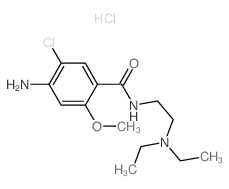metoclopramide hcl

metoclopramide hcl structure
|
Common Name | metoclopramide hcl | ||
|---|---|---|---|---|
| CAS Number | 7232-21-5 | Molecular Weight | 336.25700 | |
| Density | N/A | Boiling Point | 418.7ºC at 760 mmHg | |
| Molecular Formula | C14H23Cl2N3O2 | Melting Point | 145ºC | |
| MSDS | USA | Flash Point | 207ºC | |
| Symbol |

GHS07 |
Signal Word | Warning | |
|
Developing structure-activity relationships for the prediction of hepatotoxicity.
Chem. Res. Toxicol. 23 , 1215-22, (2010) Drug-induced liver injury is a major issue of concern and has led to the withdrawal of a significant number of marketed drugs. An understanding of structure-activity relationships (SARs) of chemicals can make a significant contribution to the identification o... |
|
|
A predictive ligand-based Bayesian model for human drug-induced liver injury.
Drug Metab. Dispos. 38 , 2302-8, (2010) Drug-induced liver injury (DILI) is one of the most important reasons for drug development failure at both preapproval and postapproval stages. There has been increased interest in developing predictive in vivo, in vitro, and in silico models to identify comp... |
|
|
Chemical genetics reveals a complex functional ground state of neural stem cells.
Nat. Chem. Biol. 3(5) , 268-273, (2007) The identification of self-renewing and multipotent neural stem cells (NSCs) in the mammalian brain holds promise for the treatment of neurological diseases and has yielded new insight into brain cancer. However, the complete repertoire of signaling pathways ... |
|
|
Utility of cerebrospinal fluid drug concentration as a surrogate for unbound brain concentration in nonhuman primates.
Drug Metab. Pharmacokinet. 29(5) , 419-26, (2014) In central nervous system drug discovery, cerebrospinal fluid (CSF) drug concentration (C(CSF)) has been widely used as a surrogate for unbound brain concentrations (C(u,brain)). However, previous rodent studies demonstrated that when drugs undergo active eff... |
|
|
Genetic mapping of targets mediating differential chemical phenotypes in Plasmodium falciparum.
Nat. Chem. Biol. 5 , 765-71, (2009) Studies of gene function and molecular mechanisms in Plasmodium falciparum are hampered by difficulties in characterizing and measuring phenotypic differences between individual parasites. We screened seven parasite lines for differences in responses to 1,279... |
|
|
Effect of different prokinetic agents and a novel enterokinetic agent on postoperative ileus in rats.
Gut 45 , 713, (1999) The effects of different prokinetic agents, the motilide erythromycin and the substituted benzamides metoclopramide and cisapride, were investigated in a rat model of postoperative ileus. These effects were compared with that of granisetron, a 5-hydroxytrypta... |
|
|
Newly discovered anti-inflammatory properties of the benzamides and nicotinamides.
Mol. Cell Biochem. 193 , 119, (1999) Our laboratory has concentrated on the possible regulation the benzamides and nicotinamides may have on the processes of DNA repair and apoptosis. Recent reports have suggested that both apoptosis and inflammation are regulated by the transcription factor NF-... |
|
|
Comparison of the effects of clonidine, loperamide and metoclopramide in two models of gastric emptying in the rat.
Fundam. Clin. Pharmacol. 29(1) , 86-94, (2015) Several methods are used to evaluate gastric emptying (GE) in rats, which is an important endpoint in preclinical drug development. Although phenol red model or monitoring of plasma acetaminophen levels are well-established procedures for GE assessment, their... |
|
|
Development and Evaluation of Melt-in-Mouth Tablets of Metoclopramide Hydrochloride Using Novel Co-processed Superdisintegrants.
Indian J. Pharm. Sci. 76(5) , 423-9, (2014) In the present investigation, a novel multifunctional co-processed superdisintegrants consisting of crospovidone and Kyron T-314 were fabricated by solvent evaporation method to develop melt-in-mouth tablets of metoclopramide hydrochloride with a view to enha... |